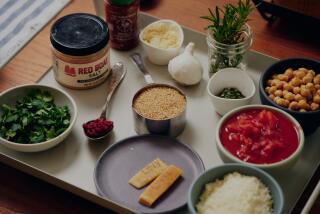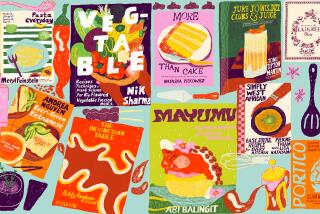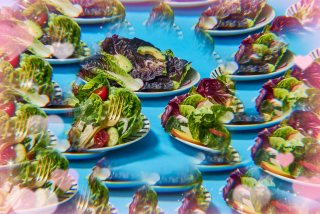IN THE KITCHEN : Don’t Hold the Mayo
When it comes to mayonnaise, my attitude is a lot like that old bit of doggerel about cigarettes:
It’s fattening
And I like it.
It’s made with raw eggs
And I like it.
It’s out of fashion, it’s bad for you and some folks say it’s revolting.
And I like it.
According to all the standards by which we judge dishes today, mayonnaise is the im perfect food.
And, you know, I like it.
If your only experience with mayonnaise is that miraculous sweet white paste that’s sold in the supermarkets as “salad dressing,” you’re probably wondering just what in the heck I’m going on about.
First of all, mayonnaise is not sweet. Not even a touch. If it’s at all sweet, it’s not mayonnaise. Try a little experiment: Put two whole eggs in the work bowl of a blender or food processor with a tablespoon of mustard and a pinch of salt. Turn the machine on. With the machine running, slowly add a flavorless oil (by flavorless, I mean both neutral and fresh--rancid vegetable oil is definitely not flavorless). The oil should be added in a thin thread at first, increasing in flow to the width of a piece of yarn at the end. When you’ve added about a cup of vegetable oil, finish the sauce with a quarter cup of good olive oil. Then add a squeeze or two of fresh lemon juice and a touch of salt.
*
That’s what real mayonnaise tastes like. If you have neither the time nor the inclination for this little experiment, there is an easier way: Go to the grocery store and pick up a bottle of Best Foods mayonnaise (sold on the East Coast as Hellmann’s). As a rule, I don’t write about brand-name products, but in testing dozens of recipes for flavored mayonnaises over the last couple of weeks, I’ve tried just about every mayonnaise and salad dressing on the market, and this was the only one that tasted like homemade. In fact, I’m embarrassed to say, when sampled side-by-side with my scratch mayonnaise, it tasted better.
I’m not alone in this belief; a recent mayonnaise tasting by Cook’s Illustrated magazine came to the same conclusion. In fact, they found, the second-best commercial mayonnaise was Best Foods “Light.” In this test too, almost every taster favored the best bottled brand over homemade.
Though mayonnaise is technically one of the “mother” sauces in French cooking, you’ll rarely see it used that way today. In fact, it has fallen so far from fashion that you probably will find a hundred restaurant salsas for every mayonnaise.
In truth, that’s probably not a bad thing. Given the relative caloric contents of the two dishes and all the food safety questions surrounding raw eggs, I’m not sure I want to recommend spooning a quarter-cup of mayonnaise on your plate (though, given a bit of fresh tarragon to flavor it, and a plate of cold chicken, I could make an exception).
*
But because you don’t want to eat a lot of mayonnaise, this doesn’t mean you don’t want to eat any mayonnaise. To my way of thinking, a tablespoon of mayonnaise per serving is not a bad thing. And a tablespoon per serving is all you need to turn some decent cold meat or fish into something spectacular.
Tuna salad is a perfect example. Though you may think of it as nothing more than lunch-counter desperation fare, treat it with a little respect (and a tad of mayonnaise), and even canned tuna can shine. Try this: Finely chop a couple of anchovies (salt-cured, preferably), spoon in some mayonnaise and beat about a minute until the anchovies disappear. Add a couple tablespoons of capers, a bit of lemon juice, some minced fresh parsley and, finally, a can of tuna (only in this case do I prefer water-packed--the aggressive fishiness of oil-packed is a little much in this dish). It’s wonderful spooned into a ripe tomato.
Or, if you want to dress your tuna salad up a bit, try this recipe--similar to the above, but made with some wonderful smoked albacore like the stuff I bought from Pete Siracusa, who sells fresh and smoked fish at many Southland farmers markets.
This is an unbelievably rich dish, and so it took some tinkering to keep from being unctuous. It needed a boost of lemon juice and even more capers than the first recipe. Most important, add some diced celery to give the dish some freshness and a textural “pop.” Each time I’ve made this I’ve added more celery, and each time I think it’s better.
*
When stuffed in a nice ripe tomato and surrounded with freshly cooked green beans, it’s enough for dinner. And more than enough, I’m willing to bet, to convince you of the virtues of mayonnaise.
*
Make this with good tomatoes and save the scraps from hollowing the tomatoes. Give the tomato scraps a little salt and pepper and serve them spooned on little garlic toasts as an appetizer. If you can’t find smoked albacore, substitute a good brand of smoked turkey.
SMOKED TUNA SALAD IN TOMATOES 4 large tomatoes 1 pound thin green beans, ends cut 1 teaspoon thin strips of basil leaves 1 tablespoon extra-virgin olive oil 1 pound smoked tuna, in 1 or 2 thick slices 5 tablespoons mayonnaise 2 tablespoons capers, plus some juice 3 teaspoons lemon juice 3 tablespoons diced celery Salt Freshly ground pepper 4 anchovy fillets
Slice off top 1/4 of tomato and, using melon baller, remove as much of insides as possible without breaking skin. (Reserve insides for another use.) Turn tomatoes upside down on platter and let juices drain.
In large pot filled with rapidly boiling water, cook beans until bright green, about 5 to 7 minutes depending on freshness. Remove from boiling water. Chill in ice-water bath to stop cooking and set color. Pat dry with paper towels. In medium work bowl toss lightly with oil and basil.
Cut tuna into 1/4-inch strips lengthwise, then 1/4-inch strips widthwise.
In medium mixing bowl combine mayonnaise, capers and juice, lemon juice and celery. Stir to mix well. Add tuna and fold gently into mayonnaise. Be careful not to break up fish. Season to taste with salt and pepper.
Lightly season to taste with salt and pepper inside of tomatoes. Spoon 1/4 of filling into each tomato. Place 1 anchovy fillet on top of each tomato. Put tomato in center of plate or arrange on platter. Lightly season green beans to taste with salt. (Don’t salt until this moment, or color will change.) Toss. Arrange around outside of tomatoes. Makes 4 servings.
Each serving contains about:
437 calories; 494 mg sodium; 68 mg cholesterol; 25 grams fat; 15 grams carbohydrates; 39 grams protein; 2.13 grams fiber.
*Bower plates and daisy tablecloth from Geri Wynn Antiques in the Pasadena Antique Center, South Pasadena.
More to Read
Eat your way across L.A.
Get our weekly Tasting Notes newsletter for reviews, news and more.
You may occasionally receive promotional content from the Los Angeles Times.








